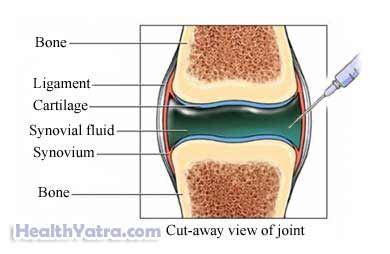Definition
This is a procedure to take joint fluid out of a joint using a sterile needle. This can be done in most of the joints in the body, but it is usually done on larger ones (eg, knee, shoulder).

Reasons for Procedure
Arthrocentesis is done to:
- Find out why a joint is painful, swollen, or fluid-filled
- Drain fluid out of a swollen joint to decrease pain and increase your ability to move the joint
- Diagnose the specific type of arthritis occurring within a joint
- Confirm a diagnosis of infection in the joint
- Check for crystals in the joint fluid, which could be a sign of gout
In some cases, the doctor may inject medicine (eg, cortisone) into the joint space after the fluid has been taken out.
Possible Complications
Complications are rare, but no procedure is completely free of risk. If you are planning to have arthrocentesis, your doctor will review a list of possible complications, which may include:
- Infection of the joint
- Bleeding into the joint
- Increased pain
- Allergic reaction
Some factors that may increase the risk of complications include:
- Infections on the skin
- Recent fever or infection
- Bleeding disorder
- Use of blood thinners
Be sure to discuss these risks with your doctor before the procedure.
What to Expect
Prior to Procedure
Your doctor may do the following:
- Examine your joint
- X-ray —a test that uses radiation to take a picture of structures inside the body, especially bones
- MRI scan —a test that uses magnetic waves to make pictures of structures inside the body
Anesthesia
Your doctor may give you local anesthesia. This numbs the area around the joint.
Description of the Procedure
Your doctor will clean the area where the needle will be inserted. Next, a needle attached to a syringe will be inserted into the fluid-filled joint cavity. Your doctor will draw the fluid into the syringe. After this, the doctor may take the syringe off and inject some medicine into the joint through the needle. After the needle is removed, the doctor will put pressure on the spot over the joint. A bandage will be placed over the area.
How Long Will It Take?
About 5-10 minutes
How Much Will It Hurt?
You may feel stinging or burning if local anesthesia is injected into the area.
Post-procedure Care
When you return home after the procedure, do the following to help ensure a smooth recovery:
- For the first 24 hours, ice the joint every 3-4 hours. Do this for 20 minutes at a time.
- To reduce discomfort, take a pain reliever.
- Ask your doctor when you can resume normal activities.
- Be sure to follow your doctor’s instructions .
Call Your Doctor
After arriving home, contact your doctor if any of the following occurs:
- Signs of infection, including fever and chills
- Redness, swelling, increasing pain, excessive bleeding, or any discharge from the site
- Pain that is not relieved by your pain medicine
In case of an emergency, call for medical help right away.
